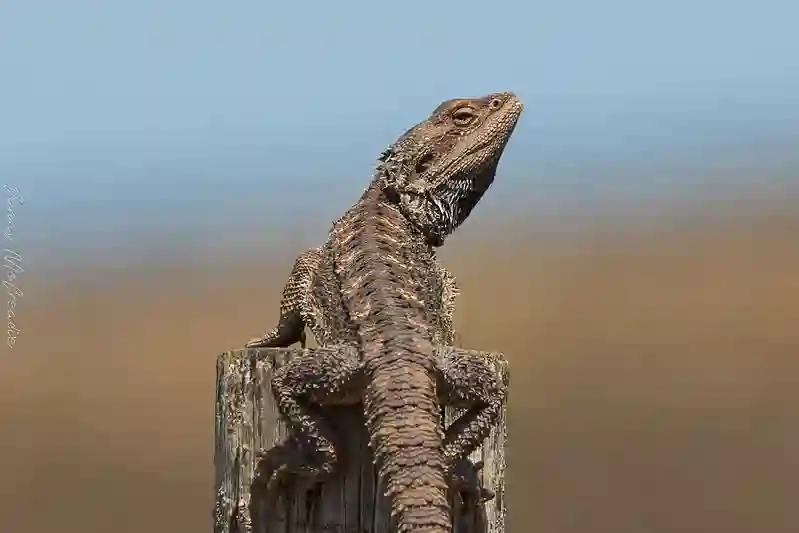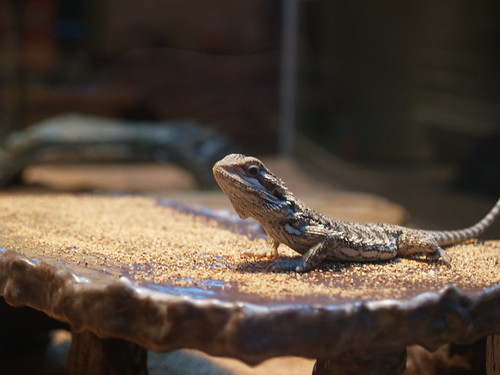It has been observed that bearded dragons turn black when affected by emotions like anger, stress, anxiety, or fear. In addition, it could also be due to a dominance pattern or an improvement in thermoregulation, particularly during breeding periods. They also become white when deprived of sufficient UVB exposure.
In fact, some experts believe that darker skin helps these reptiles absorb more heat from their surroundings when they need it most.
Temperature
Bearded dragons are cold-blooded creatures, which means they rely on external sources of heat to regulate their body temperature. As a result, bearded dragons turn black to absorb more heat from their environment.
When the temperature is low or their basking spot isn’t warm enough, they will darken their color to increase their body temperature.
On the other hand, if it’s too hot, they’ll turn lighter in an effort to release excess warmth.
Heat Stress
When these critters get too hot – say, if their enclosure isn’t properly ventilated or they’re exposed to direct sunlight for too long – it can have serious consequences on everything from their feeding habits to their skin shedding.
You see friends when a bearded dragon is experiencing heat stress, they might lose their appetite and become lethargic. They could also experience dehydration and even organ failure in extreme cases!
What to do
To ensure your bearded dragon’s comfort, provide a proper temperature gradient in their enclosure. Make sure to have a basking area with a temperature between 95-110°F (35-43°C) and a cooler area with a temperature between 75-85°F (24-29°C). Use a high-quality thermometer to monitor the temperature, and adjust the heat sources as needed.
Emotional States
Bearded dragons can also change color based on their emotions. It is not uncommon for them to turn black when they feel threatened or stressed. A darkened color may indicate they are trying to appear more intimidating to potential predators or other bearded dragons.
What Should You Do?
To minimize stress, ensure that your bearded dragon’s enclosure has adequate hiding spots and climbing opportunities. Observe their behavior and body language to determine if they are experiencing stress. If the color change is a frequent occurrence, consult a veterinarian to discuss possible causes and solutions.
Changing Color Out of Fear
Fear is another reason why bearded dragons turn black. When they feel scared or sense danger, they may darken their color as a defensive mechanism to blend in with their surroundings or to appear larger and more threatening.
What to do
Identify any potential stressors in the environment, such as loud noises, sudden movements, or the presence of other pets. Reduce these stressors, and gradually acclimate your bearded dragon to new experiences by introducing them slowly and in a controlled manner.
Dominance
In the wild, bearded dragons use color changes to establish dominance within their social hierarchy. A black bearded dragon might be displaying dominance over another bearded dragon, asserting control over territory or resources.
What to do
If you have multiple bearded dragons, separate them into different enclosures to avoid territorial disputes and dominance issues. Observe their interactions carefully to ensure they are cohabitating peacefully.
Mating Season
During the mating season, bearded dragons may turn black to attract a mate or to compete with rivals. Males often darken their beards and display head-bobbing behavior to assert their dominance and attract females.
What to do
If you are not planning to breed your bearded dragons, separate males, and females to avoid unintentional mating. If you do plan to breed them, ensure that you have the appropriate resources and knowledge to care for the offspring.
Brumation
Brumation is a period of dormancy similar to hibernation in mammals. During this time, bearded dragons may turn black as their metabolism slows down and they conserve energy. Brumation usually occurs during the cooler months and can last for several weeks or months.
What to do
Monitor your bearded dragon’s behavior and provide a cooler area in their enclosure to facilitate brumation. Ensure they have access to fresh water and reduce food intake as their appetite decreases. Consult a veterinarian if you have concerns about your bearded dragon’s health during brumation.
Illness
In some cases, a black bearded dragon may indicate an underlying health issue. Infections, parasites, or other illnesses can cause stress and result in color changes.
What to do
If you suspect illness, consult a veterinarian specializing in reptile care. Regular check-ups and maintaining proper husbandry practices can help prevent many health issues. If your bearded dragon is experiencing unusual color changes or showing other signs of illness, seek professional advice promptly.
Should You Be Concerned if Your Bearded Dragon Turns Black?
While color changes in bearded dragons can be a normal response to various factors, it is essential to monitor their overall health and behavior. A black bearded dragon may not always be a cause for concern, but it is crucial to understand the possible reasons behind the color change and take appropriate action when necessary.
To ensure your bearded dragon’s well-being, maintain proper husbandry practices, provide a clean and stress-free environment, and consult a veterinarian if you observe any concerning signs or symptoms.
Conclusion
Well, my dear fellow bearded dragon owners, I must say that learning about why my little buddy turned black was quite a journey. After much research and observation, I have come to the conclusion that there are several reasons for this phenomenon.
Firstly, temperature plays a crucial role in our beardies’ color changes. When they get too hot or too cold, their bodies react by changing colors. This is something we should always keep an eye on when caring for our pets.
Secondly, emotional states can also affect a bearded dragon’s coloring. They might turn black if they feel threatened or scared. As responsible pet owners, it’s important to make sure our dragons feel safe and comfortable at all times.
Mating season and brumation are two other factors that could cause your bearded dragon to change color.
Lastly, illness could also lead to discoloration in your pet. As such, it is essential to take them to the vet as soon as possible if you notice any unusual changes.
All in all, observing these beautiful creatures and understanding their behavior has been an incredible experience for me. It’s made me appreciate just how complex and fascinating nature truly is.


